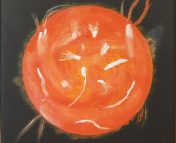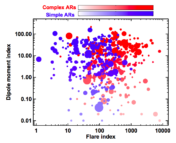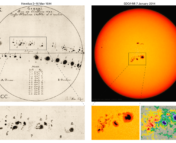Authors: Junwei Zhao, Dominick Hing, Ruizhu Chen, and Shea Hess Webber
First Author’s Institution: W. W. Hansen Experimental Physics Laboratory, Stanford University
Status: Accepted for publication in the Astrophysical Journal [open access on arXiv]
The Sun is the most well-observed star in the Universe. But even with this abundance of observations, part of the solar surface still remains mysterious.
The side of the Sun pointing away from us, the far side, remains invisible to observers at Earth until it rotates into view (see Figure 1). However, there is one way we can image the far side of the Sun indirectly. Helioseismology utilizes acoustic waves on the solar surface to study the solar interior. However, these waves also carry information about the far side of the Sun to the near side. Using helioseismology, solar astronomers can create global maps of the solar surface without directly imaging the entire star.
Solar astronomers use this technique to observe the ever-evolving solar magnetic field. Traditional methods involve creating a synoptic map, which show the solar surface at several points in time. While these can provide a tool to understand the global solar magnetic field, synoptic maps fail to capture critical information about how the global field evolves. By using helioseismology, we can create global maps for a single point in time. This is an incredibly powerful tool for modeling the global solar field from the Sun to the edge of the solar system and for predicting space weather events.
The authors of today’s paper focus on imaging solar active regions, which are strong concentrations of magnetic field in the solar surface. Active regions are a major source of space weather events that can negatively affect Earth and understanding them is essential to accurately predicting space weather. If an active region forms on the far side of the Sun, space weather forecasters want to know when it forms and have some idea of its magnetic structure.
Figure 2 shows a schematic for the acoustic waves used to image the far side of the Sun. The authors focus on multi-skip waves, which reflect multiple times before dissipating. The phase shifts in these waves are then used to derive the final map. Previous methods for imaging active regions with multi-skip waves have been developed. The authors seek to improve these methods in order to increase the resolution and accuracy of their derived magnetic field maps.

The authors then validated their derived maps using data from the STEREO satellite, which is the only satellite that’s ever imaged the far side of the Sun. However, STEREO did not have a magnetogram and only imaged the Sun in extreme ultraviolet (EUV) light. Certain EUV features are driven by magnetic fields and can be used to validate magnetic field maps. Figure 3 shows the authors’ derived magnetic map along with the STEREO data used for validation.

The authors conducted a comprehensive analysis validating their method and determined that they were more successful at imaging large active regions than imaging small active regions. They also found that their new method of imaging far side active regions was substantially more successful than older methods. Although there is still progress to be made in increasing the resolution of these maps, these results represent a leap forward in imaging the invisible side of the Sun without launching another spacecraft.
Featured image: Derived solar magnetic field map along with a near side magnetic field map from the Solar Dynamics Observatory and EUV data from STEREO. Source: Figure 5 in the paper.





Thanks for the summary, which is as nice as the paper itself :).
Glad you enjoyed it!